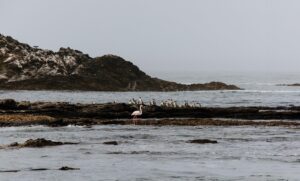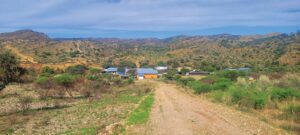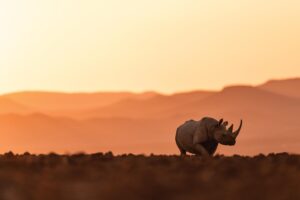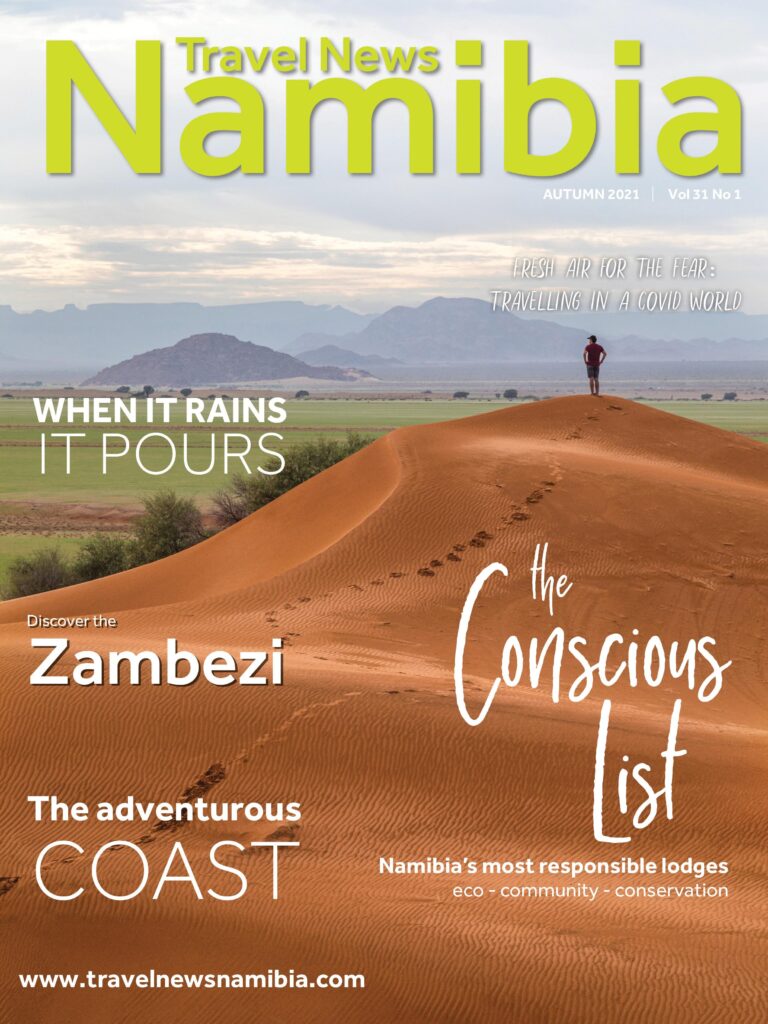
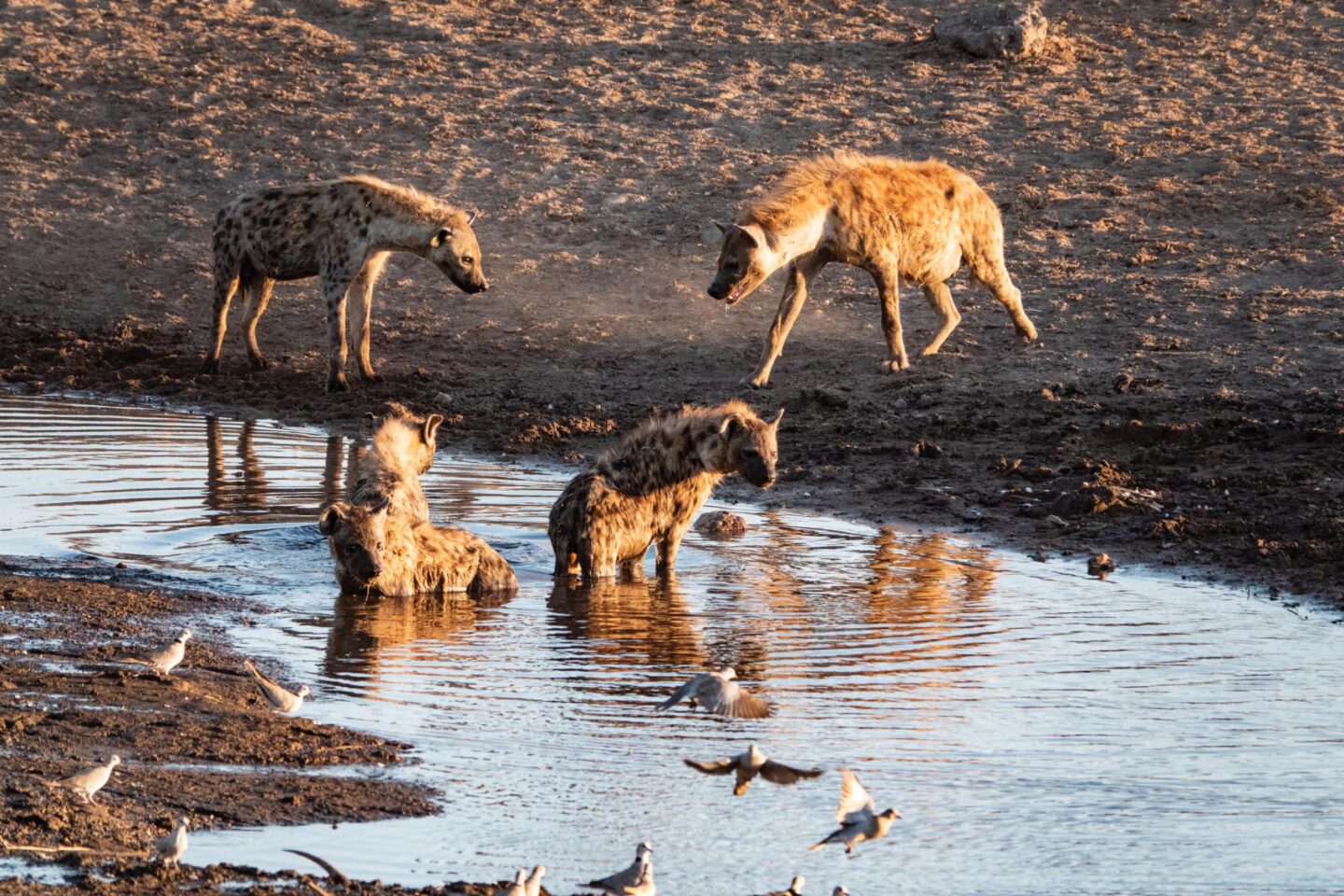
The waterhole parade
This story was written by Rièth van Schalkwyk during the lockdown in August 2020, when no foreign tourists were able to enter Namibia in what is normally the tourist high season. It was also the end of the dry winter – exceptionally dry after four years of below normal rainfall throughout the country. Since then, the pandemic has caused subsequent lockdowns in most of Namibia’s source markets, prolonging the economic devastation of the tourism sector and everybody who depends on it.
Text Rièth van Schalkwyk | Photographs Louis Wessels
From the Autumn 2021 issue
I am sitting at a waterhole near Namutoni in Etosha National Park. It is the dry season and in the distance the clouds of smoke from veld fires rise up to where at this time of year we normally hope to see plump rain clouds. It is bone dry in the park. The only green are a lone Shepherd’s Tree or the green reeds at a natural spring. It is the season when the park normally would be bustling with visitors in buses, overland trucks, self-drive vehicles and game viewers. At the waterholes the spectacle is glorious at the end of winter and all you have to do is watch the animal parade from your car. Normally you share this pleasure with game viewers packed with day visitors from lodges around the park.
But this year, because of COVID, the park is almost empty. Hardly another soul in sight, not a car on the road. Let alone an audience of people who travel from all over the world to enjoy the abundance of wild creatures on the plains, at the waterholes or resting under trees in the heat of the day. Thousands of animals on their way to or from food and water form a constant procession in this century-old park.
If you find action at a waterhole, with the parking area at the right angle for the sun and the season and you are first to park, you can actually stay there for the entire day. That is, if you are a photographer or with a photographer and if you can change your position as the sun moves. When we arrived at Chudop in the late afternoon there were thousands of doves. They were perched on the seemingly dry branches of thorn trees, looking like exotic Christmas decorations silhouetted against the sun. From the trees they fly to the edge of the water to drink and then back to their perch. This constant movement was eagerly observed for hours by opportunistic jackals which actually succeeded in catching a few doves for a late breakfast. Less successful were the two tawny eagles trying in vain to snatch a dove in flight. Their efforts, though, made for beautiful photographs and great excitement.
Never before have I seen so many hyenas coming to drink at a waterhole. Not in a pack, but one by one slouching through the yellow grass down to the natural fountain as springbok, black-faced impalas, kudus and giraffes sprint away. It never before crossed my mind that hyenas would go right into the water and actually try to catch a fish. Never imagined something edible would be hiding in the dark mud.
At the same natural spring early the next morning we were so glad the hyenas came to drink the day before, because now a baby springbok was stuck in the mud. Hyenas feasting on a baby springbok is definitely not a sight we wanted to see. It was fascinating to observe how the kudu cows and the black-faced impalas, even an eland cow, came close up as if to check on the little one in need. There was nothing any of them could do. Only when three old bull elephants arrived I thought at least they would be able to help pull it out with their trunks. But of course they were bulls. And elephants. For all my “don’t interfere with nature” principles I did consider some intervention. If only one were allowed to get out of the vehicle.
A PASSING PARADE
The animal activity is like a parade in progress. Thirty beautifully striped zebra. So photogenic with their graphic patterns forming an artwork when they stand in a perfectly positioned line to drink. And to be photographed. Then something spooks them and in a cloud of dust they storm up the embankment. It is most probably the west wind that causes the jitters every few minutes, which is also great fun to watch. The poor giraffe always have to use their strong neck to pull up an entire body from the most awkward drinking position every time the zebras get spooked. And then it takes two rounds of other thirsty visitors getting in their way before they are back in position. Just to get spooked again when a jackal is successful in getting more than feathers. Nothing seems to bother an eland – certainly not the wind. They appear in huge numbers at a perfect angle through the tree line, with the sun on their silky camel-coloured bodies. Slowly, elegantly like old ladies, they saunter down to the fountain. Unperturbed by the goings on. They choose the opposite side of the embankment, disturbing only the flock of guineafowl as they lower their massive necks. Maybe they did not even notice the guineafowls because they are exactly the same colour as the mud in the shaded side of the waterhole – a very unattractive background for a good photograph. The light is deteriorating, which means it is time to move on.
It is the middle of the day now. And hot. We are sitting on the edge of the pan in the harsh midday light. The pan is shimmering in the heat and the mirages are stunning. Hopeless for photography, but great to watch three elephant bulls, white from the salty clay of the pan, drinking a little, then snoozing like old men taking a power nap. They lift one hind leg and cross it ever so slightly over the other. Totally relaxed. Their eyes seem closed but with the binoculars I see through their long lashes that their eyes are in fact open. But no blinking. They are fast asleep with open eyes. All their movements, if they move at all, are in slow motion.
On the grass plains a secretarybird lifts his wings for us and a kori bustard puffs his feathers as I have never seen before.
“Nature as natural as it can be. And us, the observers, privileged to still have places where nature continues about its way”
A LEOPARD IN BROAD DAYLIGHT
Onwards to a little-known waterhole, just to check if the resident leopard is still on duty. We were tipped off that the leopard was there. It was an out of the way waterhole that I could not remember ever visiting. As we approached I marvelled at the beautiful old leadwood trees with doves on every dry branch. Hundreds of them. This was obviously an ancient natural spring. Coming closer we noticed a great deal of feathers. Something was feeding on the doves, but there were no jackals in sight. The strangest rock formation, calcrete or perhaps even tufa, formed a cave-like backdrop.
We were still discussing this phenomenon when we spotted the leopard. Perfectly camouflaged in the shade of an overhang with an unobstructed view of the small puddle among large rocks. I knew that this would be our day. Not only had we seen two cheetahs perched on an anthill soon after sunrise, but after all these years I was actually watching a leopard in broad daylight in Etosha. He was so close to us and yet so sure of his secret hiding place. He must have felt quite safe and unthreatened, and we were an audience with time and patience. No distractions and no movement on our side of the grandstand.
First came a zebra. Then a big black-faced impala ram. For an hour we watched the doves and guineafowl. The leopard just lifted his head but did not move an inch. Then a young impala ram entered the scene. Watching the leopard through my binoculars I just knew this was the one. The leopard was fixated on the ram. I could see his eyes and I saw the muscles in his shoulders move as he adjusted his forelegs ever so slightly. Lifting his head just a little higher. The zebra moved out of the way and the older ram left the arena.
My heart is beating fast. How on earth can I be wanting the leopard to make a kill? Willing it to be patient and hoping the guineafowl won’t spook his prey. The muscles in his entire body contract as he pounces. Right there in front of my eyes. Perfectly in focus through my binoculars. A strange strangling sound and then quiet.
I was still in shock when the leopard appeared in full view dragging his prey up from the embankment into the bush and up a dead tree. For the first time in my life I watched the scenario play out for real. Nature as natural as it can be. And us, the observers, privileged to still have places where nature continues about its way.
As we light the fire back at camp, the barn owl sits in his hiding place in the buffalo-thorn tree and the moon rises in all its magical splendour. TNN


